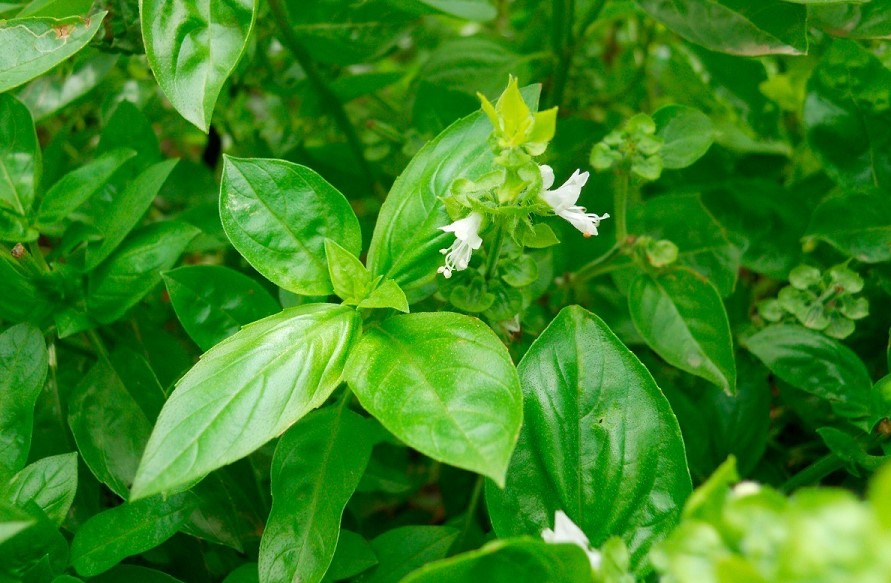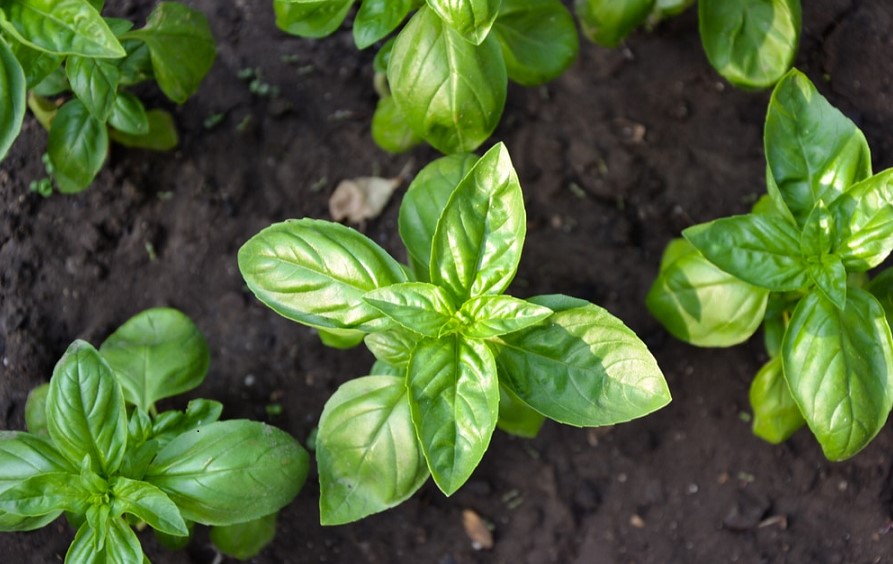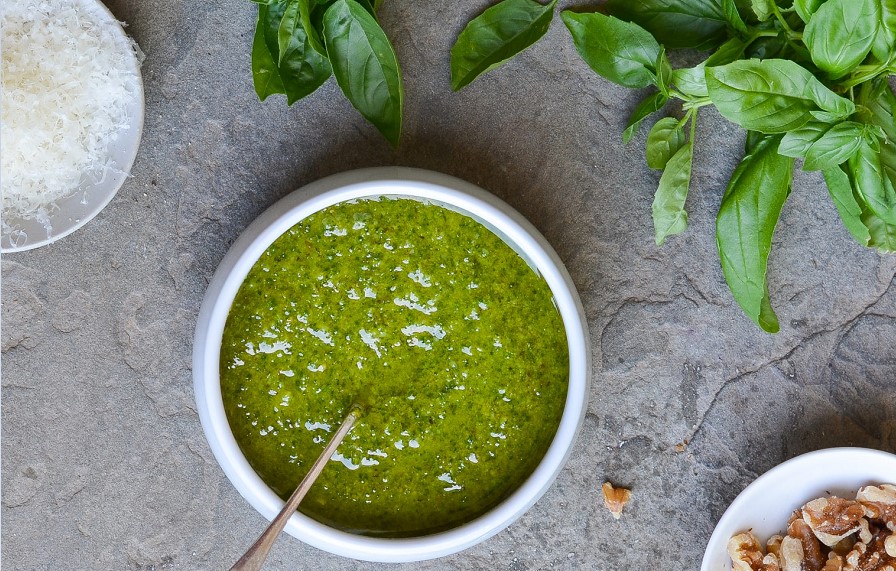The flowers are beautiful! Why would you want to stop basil from flowering? Those purple or white flowers look cute and have a gentle aroma. We can just leave them be. And you certainly can. But there will be consequences. Basil leaves will partly lose their tenderness and fragrance. Read on and decide if you want those basil flowers. If not, you’ll know what to do.
A basil plant is a frequent inhabitant of the herb garden. This herb is not a perennial, and you’ll have to sow it every year. But it’s certainly worth it, as a basil plant gives us one of the favorite herbs that people all over the world enjoy immensely. It’s even sometimes called the “king of the herbs.”
Basil plants, which originally came from tropical Asian regions, are now grown in countries with milder climates like the Mediterranean region and North America.
A basil plant is common for both outdoor gardens and indoor container gardening. Growing basil is not overly complex, and the result is — a fresh and aromatic herb that can be used in hundreds, if not thousands, of dishes.

Contents
The life of the basil plant is short and bright
As we’ve already mentioned, a basil plant lives for one year, and its short life includes 4 basic stages:
Seedling stage. It usually takes about 7-14 days for the seeds to sprout. They are tiny and fragile at this point.
Juvenile stage. That’s the stage when most of the growth happens. A basil plant rises to 12 inches and gets most of its foliage.
The growing season is when you can start harvesting — 3-4 weeks after sprouting.
Transition stage. At this stage, the plant is getting ready for reproduction, so very few new leaves grow.
Reproduction stage. That’s when the basil plant first produces flowers. White or purple flowers bloom and the basil plant doesn’t have any force left to produce leaves.
Basil flowering turns into the appearance of basil seeds, and the circle of life is complete. Afterward, the plant will die, only to be reborn next year from a single seed.

Basil flowers: prevent them or deal with them
Now let’s weigh up all the facts about basil flowers and everything we will gain if we prevent basil plant flowering or let them bloom.
Prevent the bloom. Pruning is the key
The reason most people prefer to prevent basil flowering is the decline in the quality of the basil leaves. When flower buds appear, followed by basil flowers, the leaves lose their exquisite fragrance and tenderness.
The reason is obvious. The basil plant aims at reproducing, and the basil leaves are definitely not the priority. There are simply no resources left to sustain their growth.
That sounds like a good enough justification for stopping basil plants from flowering because our aim is different.
We want leaf growth; we want a bushier plant, and we really need that fresh pesto.
So, what do we do? We prune. It’s pretty easy because you prune your basil plant by picking the leaves for cooking. Just make sure that you do it regularly and correctly.
By pruning basil plants, we mean cutting their stalks and leaves from the top. You can start doing that when the plant reaches 8 inches in height. You don’t want it to grow higher. Your goal is a bushy basil with plenty of leaves, not a giant stalk.
When you prune, always leave at least two-thirds of the plant. This way, you’ll encourage your basil plant to grow leaves and not produce flowers.
Basil flowering. Signs and initiators
An interesting fact: many plants start blooming under stress. So if the purple flowers of basil plants haven’t won over your heart, and you’d rather enjoy its tender fragrant leaves, pay attention to the following events that can trigger basil flowering to start.
Too much water
As the herb originated in tropical and subtropical climates, basil needs regular watering (about 1.5 inches per week). If you give it too much water, it will be stressful for the basil plant and can provoke the blooming.
Too much heat
Another cause of basil plant stress is heat. When the temperatures are too high to produce seeds before withering away, the basil plant will bloom.
Plucking unexpected flower heads is the best choice if you don’t plan on having basil flowers.
Basil flowers are not that bad
We’ve just given you the arguments in favor of averting a flowering basil plant. Now, it’s time for the defense of the purple cuties. Are they really that bad? Let’s find out.
Basil flowers are safe to eat. Basil flowers are edible.Eating basil flower heads is perfectly fine. Their fragrance is a little milder than one of the basil leaves, but still very similar.
You can come across an occasional bitter-tasting basil flower, but it’s not often.
The most common way of eating these flowers is by adding them to salads. Fresh strawberries and basil are a well-known elegant combination. Or make a seasoning mix with other herbs after drying them. You will have a wonderful mixture.
And one should never forget the pizza. Basil is an integral part of the famous pizza Margarita, along with tomato sauce and mozzarella cheese. A flower will be enough to add to the divine aroma.
Basil flowers provide seeds. We know that basil is an annual plant, so next year you’ll need to sow the seeds in the ground again. If you save basil seeds, next year you won’t have to worry about purchasing them.
You’ll just throw them in the ground and wait for the new basil plants to sprout and bring you fresh basil again.
Basil flowers are good for garden pollination. If you grow basil in the garden, you are lucky. A basil flower is extremely popular among bees.
With this delicious and aromatic herb in your garden, pollination will be vigorous. That’s one more perk for keeping flower buds and letting basil produce flowers. We even saw people putting basil flowers in a bud vase. As you probably know, we usually put a rose in a bud vase. It turns out, basil is good enough for that, too.

Possible challenges
Flowering is not the only issue a gardener may have with basil.
Although basil isn’t the most difficult plant to grow, there are still challenges that are better to be warned about. So, you are ready if they occur.
- White or brown spots on the leaves. They are typically indicators of a fungus infection. It’s quite common for basil, and you don’t need to worry. Use some fungicide that you trust and solve the issue.
- The plant is wilting. It’s most likely a sign of overwatering. Due to excessive moisture, the plant got root rot. To solve that problem, make sure that your plant has appropriate drainage, cut the wilted leaves, and provide the plant with more sun exposure.
- The plant is losing its leaves and looks awful. That can be because of the deficit of water. Basil needs to stay hydrated enough. The solution is to give it water, and soon you’ll understand if the plant is salvageable, or you were too late.
Those are some of the most common problems you can face as a gardener growing basil. Hopefully, you’ll be able to avoid them.
Bonus recipe
We simply couldn’t finish the article without a little treat for you. It’s a classic pesto recipe from Genova, which is known as the city this amazing dish originates. Although you can make pesto from a great variety of ingredients, the ageless classic from North Italy has basil as its key ingredient.
- For this classic authentic recipe, you’ll need 4 cups of fresh basil leaves (the best fresh basil is, of course, the one that you grew in your garden).
- Mix basil with 0.5 cups of olive oil (extra virgin will be the best), 0.3 cups of pine nuts, and 2 cloves of garlic.
- Put the mixture in the blender and blend until the basil gets creamy.
- Then add 0.25 cup of Parmigiano-Reggiano cheese and 0.25 cup of Pecorino Sardo, both freshly grated.
- Sprinkle 1 teaspoon of salt and continue blending until you reach the desired texture of the sauce.
The texture depends on personal preferences, some folks like it smooth and creamy, while others prefer a little crunch.
Then you can put the pesto into a bowl, top it with 0.5 inches of oil (for better storage) and let it stay in the fridge for some time, so all the ingredients and their aromas could mix and create a perfect pesto that you will enjoy for some time, as this pesto can be stored in the fridge (but it won’t last long, that’s for sure).
Of course, you can substitute Italian cheeses and use the kinds you prefer, but we recommend trying an authentic recipe at least once.

Final thoughts
Now you know that if you want to enjoy delicate, fragrant leaves of basil, you should avert basil flowers. When basil produces flowers, it stops growing new leaves, and their aroma and texture change too.
It’s quite easy to avoid the blooming. Simply prune the basil (but always leave at least 2/3 of the plant untouched). Pruning is very efficient, and you can combine it with harvesting. Two birds with one stone.
However, basil flowers are perfectly edible and have a similar taste to the leaves. You can put a flower bud in the salad, and get a delicate fragrance.
Now you have all the information you need and can make an educated decision about whether to stop basil from flowering or not. We were happy to help.
Frequently asked questions
Should I stop my basil from flowering?
It’s up to you. If you prune your herb and don’t allow it to bloom, its leaves will remain delicate and have an intensive fragrance. If you let it flower, the leaves will be tougher and less tender. However, flowers are edible.
Eat basil flowers using them as seasoning for salads, or make an excellent pesto with basil, cheese, and pine nuts. Basil flowers will also give you seeds you’ll sow next year. Besides, they are an excellent attraction for bees. That will be great for your whole garden. The choice is yours.
How do I keep basil from flowering?
It’s quite easy — you prune it. You can do it while harvesting. Cut the top of the stem, but leave at least 2/3 of the sprout intact. This way you’ll stimulate the active growth of the leaves and prevent flowering. Repeat the procedure every couple of weeks, and there will be no flowering for your basil.
What triggers basil to flower?
Basil like other herbs may unexpectedly start to bloom if they experience some stress. What can be considered a stressful situation for basil? For example, very hot weather or excessive watering. Avoid these situations, and your basil will not surprise you with flowers.
Can you still use basil after it flowers?
After blooming, the plant remains edible and tasty. Its quality deteriorates a little: it becomes less fragrant, and the leaves and stems — are a little rough.
At this point, basil is already in the final stage of its life and is losing its best qualities. You can see some withering leaves and sometimes even feel bitterness in the taste of the herb.


